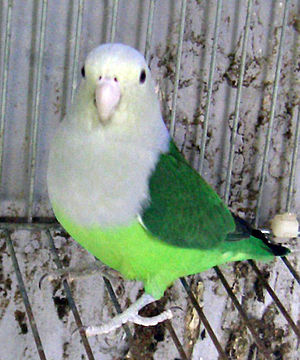Gray-headed
| Gray-headed | ||||||||||||
|---|---|---|---|---|---|---|---|---|---|---|---|---|

Gray-headed |
||||||||||||
| Systematics | ||||||||||||
|
||||||||||||
| Scientific name | ||||||||||||
| Agapornis canus | ||||||||||||
| ( JF Gmelin , 1788) |
The Gray-headed lovebird ( Agapornis canus ) is a bird art that the family of authentics Parrots (Psittacidae), subfamily eclectus parrots , heard (Psittaculinae). It is one of the types of lovebirds ( agapornis ), in which one can distinguish between males and females at first glance.
description
The male has a gray head, throat and nape while the chest is light gray. The rest of the plumage is green. The hand wings are black in color and the tail feathers have a black stripe, the edge of the wing is white. The female is completely green, only the face is streaked with gray. The beak of both is horn-colored. With a size of 13–14 cm and a weight of 25–28 g, the gray-headed ones are among the smallest within their genus. They reach an age of 10–20 years.
distribution and habitat
Gray-headed is the only species that is not at home on the African mainland, but on Madagascar and its surrounding islands. They live on the coasts and occasionally on some surrounding islands. Preferred habitats are grasslands with bushes, forest edges and cultivated landscapes such as rice-growing areas at heights of up to 1500 m.
Utterance
During the flight and at dusk, the calls are shrill and metallic. But also a faint clatter and shrill alarm calls can be heard.
Lifestyle and diet
They live in groups of up to 30 animals. Their diet consists of grass seeds, fruits and rice.
Reproduction
They nest in tree hollows and pad their nest with bits of grass and bark. Between November and December, 2–5 eggs are laid. These are only incubated by the female for 21–23 days. The rooster is responsible for feeding the female. The nestling period is 6 weeks.
Keeping and stock
The population of wild gray heads is currently stable; hardly any animals are imported any more, but they are reared, although breeding is not that easy.
Subspecies
- Agapornis canus canus ( JF Gmelin , 1788)
- Agapornis canus ablectanea ( Bangs , 1918), native to southwest Madagascar, more bluish plumage and purer and more extensive gray
literature
- Georg A. Radtke : Inseparable (Agaporniden): keeping, breeding and color variations , Franckh, Stuttgart 1981, pp. 55–58, ISBN 3-440-04947-7
- Dirk Van den Abeele: Agapornids. Volume 1: species, husbandry, nutrition, breeding. Arndt-Verlag , Bretten 2010, ISBN 978-3-9813383-1-7 .
Web links
- Agapornis canus inthe IUCN 2013 Red List of Threatened Species . Listed by: BirdLife International, 2012. Retrieved October 26, 2013.
- World Parrot Trust , accessed February 3, 2011
- agapornis.ch , accessed on February 3, 2011
- Agapornid species , accessed February 3, 2011
- Agapornids , accessed February 3, 2011
- Videos, photos and sound recordings of Agapornis canus in the Internet Bird Collection
Individual evidence
- ^ ITIS Report , English, accessed on February 3, 2011